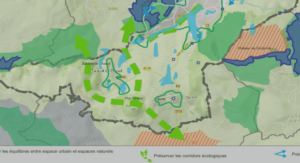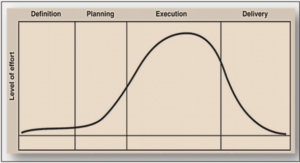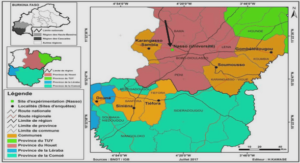Evolution t-T et déformations de l’Unité des Flyschs
Overview of the structure and tectonic evolution of the internal domains of the Betics
General geological context
From the external toward the internal zones, the Betic–Rif realm is composed of several tectonic domains (Fig. 1): (a) the Guadalquivir and the Gharb foreland basins; (b) the External Zones of the Betics and Rif; (c) the Flysch Trough units (FTU); (d) the metamorphic complexes of the Internal Zones 113 and (e) the Alboran Sea basins. The non-metamorphic External zones and metamorphic Internal Zones (e.g. Fallot, 1945; García-Hernandez et al., 1980; Balanyá and García-Duenas, 1987) are separated by a major tectonic contact, called the Internal-External zone boundary (IEZB) (Platt et al., 2013) and by the Flysch Through Units (Crespo Blanc and Campos, 2001; Fernández-Fernández, 2007). Figure 1 : Geological map of the Betic and Rif Cordilleras (modified after Comas et al., 1999; Frasca et al., 2015). Colored circles show the age of published apatite fission track (AFT) and (U-Th-Sm)/He data. (Platt et al., 2003b; Clark et al., 2009; Reinhardt et al., 2007; Johnson, 1997; Barbero et al., 2007; Esteban et al., 2004; Andriessen et al., 1996; Platt et al., 2005; Sosson et al., 1998; Lonergan and Johnson, 1998; Vazquez et al., 2011; Janowsky et al., 2017). WAB: West Alboran Basin. The Internal zones of the Betics recorded a cyclical tectonic evolution marked by: 1) high-pressure during Variscan contraction followed by late Variscan partial melting (e.g., Sánchez-Rodríguez and Gebauer, 2000; Zeck and Whitehouse, 2002; Gueydan et al., 2015; Sánchez-Navas et al., 2014, 2017); 2) Jurassic Tethys opening, as suggested by Jurassic ages of low-pressure protoliths of eclogite and pyroxenites layers in the western Alboran peridotites (Sánchez-Rodríguez and Gebauer, 2000; Tubía et al., 2009); 3) high-pressure metamorphism during Alpine nappe stacking followed by a regional Miocene extension and crustal thinning in the Alboran domain is responsible for the LP-HT metamorphism event and the main metamorphic assemblages in the rocks (e.g. Platt et al., 2013). The internal zones of the Betics are structurally made of four distinct tectonic nappes: the NevadoFilabride, the Alpujarride, the Malaguide and the Dorsale Calcaire unit, from the lower to the upper units, respectively. The Nevado-Filabride and Alpujarride units of the Alboran domain are strongly affected by Paleogene to Neogene high-pressure/low-temperature (HP/LT) metamorphism and Cenozoic extensional deformations (e.g. Azañón and Crespo-Blanc 2000; Platt et al., 2005; 2006). The unmetamorphosed External Zones consist of three main units, the Prebetic unit, only found in the eastern and central Betics and the Subbetic unit forming the External Zones s.s and the FTU positioned between the Internal (Alboran) and External (European/Iberian) units. The Subbetic and Prebetic consist of Mesozoic to Tertiary sediments that were deposited on the Variscan basement of the Iberian paleomargin (e.g. García-Hernandez et al., 1980; Martín-Chivelet et al., 2002). The FTU are Cretaceous to Miocene deep-water sediments deposited in a basin floored by transitional or oceanic crust (Durand Delga, 2000).
The internal zones and Alboran sea basin
Alboran Sea basin The deep crustal and lithospheric structure of the Gibraltar arc region comprise (Fig. 1 and 2) the Betic -Rif arcuate cordillera on one side and the Alboran Sea in the back-arc area. The crustal thickness is 15-20 km in the Alboran Sea whereas it reaches 50-45 km beneath the western Betics and the Rif (Fig. 2) (e.g. Thurner et al., 2014; Mancilla et al., 2105a; Palomeras et al., 2017). The basement of the Alboran Sea basin is made of metamorphic Paleozoic rocks. This basin is divided in three sub-basins formed during late Oligocene to late Miocene extension, the Western Alboran Basin (WAB), the East Alboran Basin (EAB) and the South Alboran Basin (SAB) (Comas et al., 1999). Sediment thickness reaches 8 to 10 km in the WAB where the oldest sediments are Burdigalian (Hatzfeld, 1978; Comas et al., 1996; Iribarren et al., 2009; Do Couto et al., 2016) and only 2-3 km in the SAB and EAB where the oldest sediments are Serravallian (Martínez-García et al., 2017). The extension in the Alboran basin is associated to the rapid cooling of Alpujarride rocks drilled at ODP site 976 (18-20 Ma), temporally consistent with the age of rapid cooling of the Alpujarride unit at ~21-17 Ma (Monié et al., 1994; Platt et al., 2003b; Esteban et al., 2004). Since the late Tortonian (9Ma), the Alboran Sea has been affected by compressional deformation (e.g. Bourgois et al., 1992; Comas et la., 1999; Martínez García et al., 2011, 2013, 2017). 115 Figure 2 : Main crustal features of the Betics and Alboran Sea and the Flysch Trough Unit (orange). Arrows depict GPS velocities after Vernant et al. (2010). Moho depth variations beneath the Betics are based on Vs velocity and P-receiver functions from Mancilla et al. (2015) and Palomeras et al. (2017). Light blue domain below the Gibraltar arc represents the domain of thick crust (40-50 km) and darker blue domain represents the thinned crust (30-15 km) of the Alboran Sea (Palomeras et al., 2017). Position of the slab tear (thick red-line) is drawn after Mancilla et al. (2015b). Western Alboran Basin (WAB) depocenter is shown in light yellow. SAB and EAB are the South Alboran Basin and East Alboran Basin, respectively.
Nappe stacking in the Internal Zones
Extensional tectonic features currently dominate the structure of the internal zones. However, the Nevado-Filabride (NF) and Alpujarride (AJ) units preserve HP/LT mineral assemblages equilibrated during earlier Alpine stages of convergence (Gómez-Pugnaire and Fernández-Soler, 1987; Goffé et al., 1989; Vissers et al., 1995; Booth-Rea et al., 2002; Platt et al., 2006). The Nevado-Filabride stratigraphy is composed, for the most part, of Late Paleozoic to Permian-Triassic micaschists, quartzites and marbles locally intruded by orthogneisses (Nieto et al., 2000; Martínez-Martínez et al., 2010; Puga et al., 2011; Gómez-Pugnaire et al., 2012; Sanz de Galdeano and Lopez Galindo, 2016). The Nevado-Filabride units were affected by HP/LT metamorphism (1.4-2 GPa, 600-690°C) followed by LP-LT retrograde conditions (0.6-0.3 GPa, 600-300°C) (e.g., Gómez Pugnaire et al., 2012; Augier et al., 2005a). Based on a number of geochronological methods (Rb-Sr, Lu-Hf, Ar-Ar, U-Pb), ages for the 116 HP metamorphism range between 60 and 17 Ma (Monié et al., 1991; Puga et al., 2002; Augier et al., 2005a; Platt et al., 2006; Sánchez-Vizcaíno et al., 2001; Gómez-Pugnaire et al.,2012; Kirchner et al., 2016; Li and Massonne, 2018). Cooling ages in the Nevado-Filabride and the Alpujarride indicate that after a HT metamorphism recorded at about 22 Ma the internal zones were exhumed rapidly to upper crustal levels by 18 Ma (e.g. Platt et al., 2003b). Zircon fission-track data from the NF unit further document rapid cooling from 300-240°C to near-surface temperatures between 12 and 6 Ma (Johnson, 1997; Vásquez et al., 2011). Based on new petrographic and geochronological Rb-Sr constraints, Kirchner et al. (2016) argue that the NF unit recorded HP metamorphism only after 20 Ma. The Alpujarride unit represents the Variscan basement of the Alboran domain. It lies structurally above the Nevado-Filabrides unit but shows a very similar lithostratigraphic succession represented by metamorphosed Paleozoic graphitic schists, followed by Permo-Triassic schists and quartzite and middle to late Triassic marbles and dolomites. The Alpujarride unit was affected by lower peak HP-LT conditions (from 0.7-1.1 GPa, 400-580°C) around the middle Eocene (Augier, 2005; Platt et al., 2013). The western Alpujarride unit is characterized by the presence of the Ronda peridotite body. These peridotites are associated with HT metamorphic rocks and intruded by several granitic dykes, dated from 22.3±0.7 to 18.9±3.0 Ma (Esteban et al., 2011; Sánchez-Rodríguez and Gebauer, 2000), crosscutting both the peridotite and the host rocks and have been The Malaguide complex is structurally the highest tectonic nappe of the internal zones. It is composed of a Paleozoic sedimentary succession unconformably overlain by Permo-Triassic conglomerates (Durand Delga, 1972; Perri et al., 2013; Esteban et al., 2017). Mesozoic and Cenozoic sediments are rarely preserved in the Malaguide unit. Where present, unmetamorphosed Jurassic and Cretaceous limestones pass into an alternation of calcareous sandstones, conglomerates, marls and marly limestones of Paleocene age. The Eocene sequence is represented by Nummulites and Alveolines limestones unconformably deposited on the Jurassic or early Cretaceous strata. On top of the Malaguide complex, were deposited different sedimentary formations belonging to the Upper Oligocene-Aquitanian Ciudad Granada group and the Burdigalian Viñuela group .The Ciudad Granada group clearly postdates an early Alpine deformation stage but predate the main compressive tectonic and metamorphic evolution and exhumation of the Betic-Rif belt, which culminates in late Burdigalian (Crespo-Blanc et al., 2001). The Burdigalian Viñuela group is found on top of the Ciudad Granada group. This formation is considered as transgressive because its area of deposition is wider than for the Ciudad Granada group and unconformably overlies both the Alpujarride and Malaguides units. The clasts forming the detrital material are sourced from the Malaguide and Alpujarride metamorphic basement, thus providing constraints on the timing of subaerial exhumation of the internal zones.



